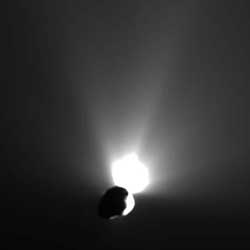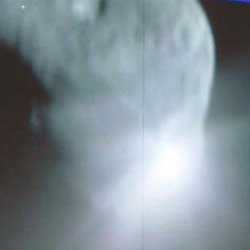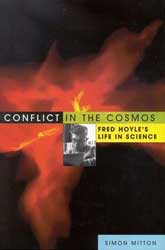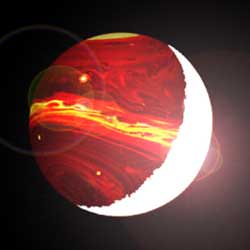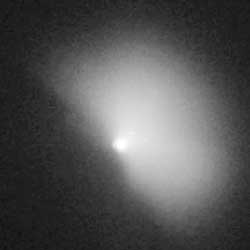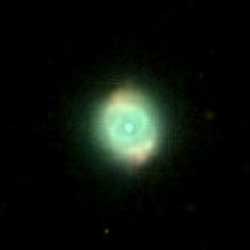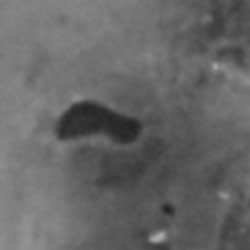
Possible lake on Titan. Image credit: NASA/JPL/SSI. Click to enlarge.
Listen to the interview: Summer at the Lake… on Titan (6 MB)
Or subscribe to the Podcast: universetoday.com/audio.xml
Fraser Cain: Let’s say I’m standing on the surface of Titan beside this feature, what would I be seeing?
Carolyn Porco: Well, we’re not absolutely sure, but if it is, in fact, a lake of hydrocarbons, then you would see something that would look rather dark. It may have some materials disolved in it and perhaps waves would be lapping up at the shore which would of course be ice, water ice. Mind you, it’s incredibly cold. Overall, the scene would be very dark because high noon on Titan is like deep Earth twilight, and it might even be possibly raining methane because this feature has been found in the place on Titan where there seems to be the most clouds and therefore the greatest likelihood of rain. Not that Titan is a very cloudy place, mind you. We haven’t seen many clouds on Titan. Where we’ve seen clouds is mostly in the south polar region where this feature the size of Lake Ontario has been found.
Fraser: Now I know that images of Titan taken by Voyager and other telescopes show it as a very smoggy, cloudy world. So, how can we see the lake?
Porco: There’s a difference between smog, haze and then clouds. Clouds are particulates of some condensable material; it could be liquid droplets or the fact is if they’re high enough they could be solid particles. On the Earth, cirrus clouds are made of water ice, unlike your normal cumulous clouds that rain on you; they rain liquid water. So we could have a similar thing going on Titan, except the material, of course, is methane. But as I said, there aren’t many clouds. It’s not clouds which are making the surface of Titan so difficult to see from high above. It’s haze particles – these are haze particles, like smog particles on Earth – probably made, almost certainly made, of hydrocarbon materials, polymers probably, of carbons all linked together. These are very small particles, but the atmosphere is very very thick; hundreds of kilometres thick with this stuff. If you’re standing on the surface, you can, of course, see the surface and see even to the horizon, and a bit through it. Mind you, recall what the images taken by the Huygens probe looked like. We could see to the horizon, once the probe was on the surface and took pictures, we could see to the horizon. But if you look up through the very thick atmosphere, or if you’re above looking down, then your path through this thick atmosphere filled with haze is so long, that it’s difficult for visible light to get through. And of course, we see with visible light. In images taken with Voyager, and Voyager had a camera that could look only to the long end of where humans see with their eyes; in fact, a little beyond where we see with our eyes. But nonetheless, not far enough to see down to the surface of Titan. But with the Cassini cameras, we have used a trick that was discovered basically by ground-based astronomers. If you go to the longer wavelengths in the electromagnetic spectrum, you go into the near-infrared, you can in fact see down to the surface of Titan. Those are the wavelengths that we have used to image the surface of Titan with our cameras, and of course, it is in those wavelengths that we discovered this lakelike feature on the surface.
Fraser: Now, if it isn’t a lake of liquid hydrocarbon, what else could it be?
Porco: Well, we’re not completely sure, 100% sure, that it’s filled with liquid. Perhaps it was a depression that once was filled with liquid, and all the liquid has since evaporated, and we’re now seeing the residue of what was left behind. So it could be solid hydrocarbons that still would form a flat surface. You could imagine a salt lake bed on the Earth; the salt having been left behind after the water evaporated. So we could be seeing something that is just solid material. That’s the two basic possiblities: it could be solid material or it could be liquid. We won’t know for sure whether or not it’s liquid until we have the opportunity to see a reflection of the Sun in the surface of this body; a specular reflection, or mirror like reflection like you can see if you’re flying in an airplane over Minnesota for example. Looking down on the ground and it’s daylight, you can see specular reflections; you can see the image of the Sun glinting off the surface of all the many lakes that dot the landscape of Minnesota.
Fraser: That’s incredible, you’ll be able to see that?
Porco: We won’t be able to see that with our cameras, probably, because the geometry won’t allow us to. The solar illumination geometry and the fact that, at the wavelengths that even the Cassini cameras can see, if we look through too long a path length in the atmosphere, things get very hazy and fuzzy, and we don’t get a clear view of the surface. However, there are other instruments on Cassini that work at longer wavelengths than we do, and they go further into the near infrared. They have an easier time seeing down to the surface, and it’s possible – we have to check the upcoming encounters with Titan. So this is not a certainty yet, but at least in principle it’s possible that they could see a mirror like reflection off the surface of this body, if in fact it’s liquid. The jury is still out on this, and we may be lucky to have the kind of circumstances on future flybys of Titan to catch whether or not it’s truly liquid.
Fraser: When will Cassini have a chance to revisit the area?
Porco: I’m not quite certain of that. There are people on my team who are busy planning the Titan flybys; planning the imaging sequences for each of the upcoming Titan flybys would know that better than I do. But I think it may not be until later on in the tour when we really have a good look again at this feature. As I’ve said many times, it’s going to take us years to work out what’s truly going on on the surface of Titan. We come by it many times during the course of this mission, which ends nominally in the middle of 2008. If we’re lucky enough, and the American Congress is willing, we’ll get an extension, and we could be observing bodies in the Saturn system for the next decade. But right now we have something like 39 further encounters with Titan.
Fraser: And if it does turn out to be liquid hydrocarbon, what does that tell you about Titan’s geology or its history?
Porco: It tells that at least in part, the thinking that we had about the methane cycle on Titan, and the amount of methane in the atmosphere is correct. Because there had been predictions that the surface of Titan would have some liquids on the surface. And we haven’t seen as many as some of the models had predicted, but if there is any at all, that gives a source of the methane that’s in the atmosphere, if there’s some liquid on the surface. Of course, the next question is: how did that amount of methane get into the atmosphere to begin with? Did it come from volcanoes, or did it come from some other source? The question of how methane can even exist right now on the surface of Titan, when we know it’s being broken up in the upper atmosphere. But still, it confirms for us, at least in part, some of our thinking about what is going on between the surface and the atmosphere, and that’s interesting to know. This is another atmosphere, in many ways similar to our Earth. It gives us another example to study in learning about our own atmosphere. Bear in mind that Titan also has a kind of mild greenhouse effect going on. It’s surface temperature is 12-degrees Kelvin greater than it would be otherwise, if there were no methane in its atmosphere. So, we stand to learn a lot about our own planet, and what makes our own planet unique, and what makes it have anything in common at all with some other body, like Titan, by studying Saturn’s largest moon.
Fraser: Have you imaged Titan well enough now to know that this is the only feature like this on the planet?
Porco: Oh, not by a long shot. We’re just beginning here. These are early days. I don’t know what percentage of the surface has been covered yet, but it’s still a small fraction at the kind of resolution that we would need to see these kinds of features. So no, we have a long way to go, and I think there’s going to be a lot more exciting discoveries in store, so stay tuned is the message really.

